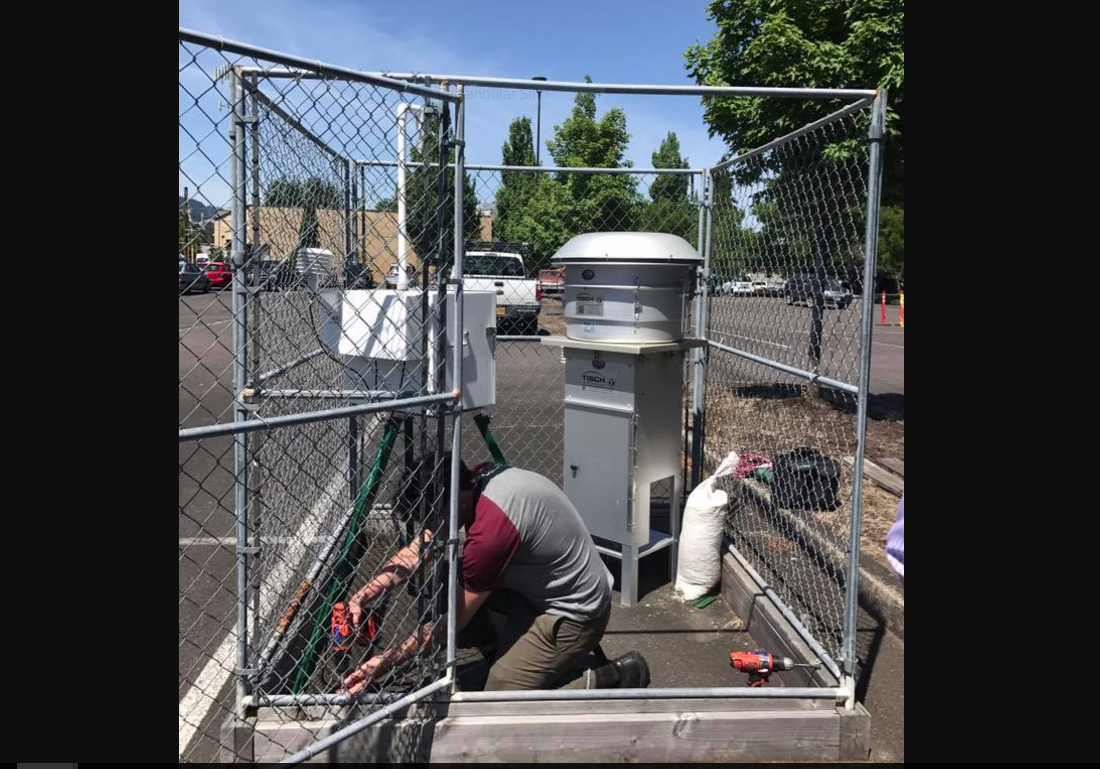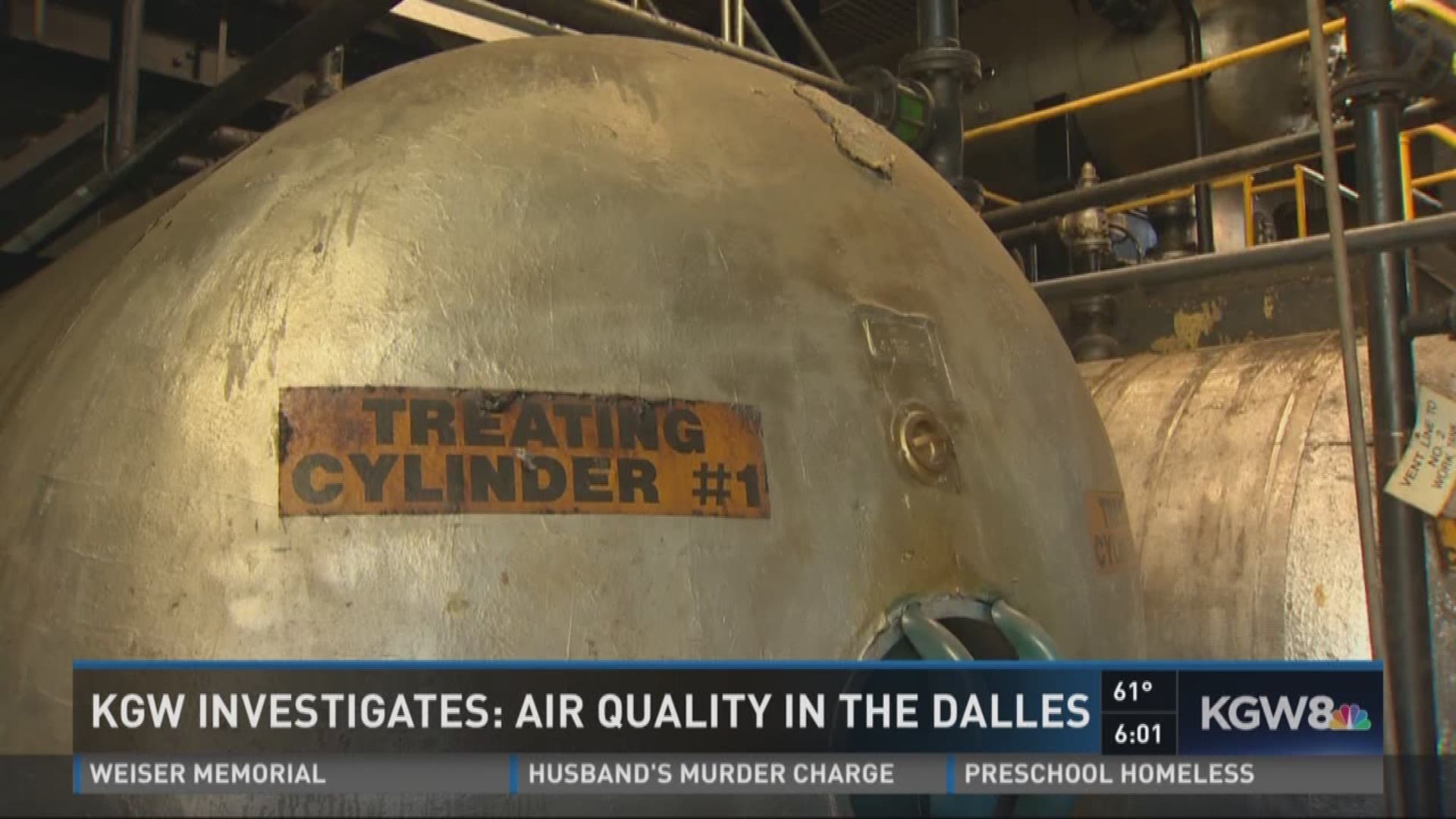THE DALLES, Ore. – On Monday, the Oregon Department of Environmental Quality removed a machine resembling a Star Wars droid from its temporary home at a Southeast Portland Fred Meyer across from Bullseye Glass, where it’s been monitoring heavy metals for over a year.
A machine like that is now headed to The Dalles.
It will be set up along the small town on the Columbia River, as part of a DEQ air toxics monitoring project.
The DEQ chooses a couple of sites to set up a full toxics monitoring project every year so they can understand exactly what level of heavy metals and other toxic substances are in the air, and which polluters are likely emitting them.
Last year after moss studies found high levels of cadmium and arsenic near Bullseye, the DEQ monitored the air. The heavy metals monitor in Portland showed that after Bullseye Glass implemented pollution controls, detectable heavy metals dropped markedly.
The machine may be up for a bigger challenge in The Dalles, where several industrial sites pump out varying levels of toxic substances in the town of 15,000 residents.
“DEQ has never done a full range of air toxics monitoring in the community, meaning the DEQ doesn’t know exactly what toxics people are exposed to every day,” said DEQ spokesman Greg Svelund.
The biggest offender is Amerities, a railroad tie plant that’s been operating on the west side of town for nearly a century. Last year, Amerities racked up hundreds of air quality complaints from residents who said the acrid smell of a chemical called naphthalene polluted the air.
Some residents claim they have experienced health problems from the chemical, which the World Health Organization labels a carcinogen.
Amerities hasn’t broken any laws. It operates well within its DEQ air quality permit and could legally emit even more naphthalene and other chemicals called polycyclic aromatic hydrocarbons (PAHs) through its creosote treatment process.
Background: Toxic air concerns residents in The Dalles
The DEQ took action by installing PAH monitors last year. That limited monitoring project is still underway and initial results found high levels of naphthalene at a county building near the plant.
Still, the DEQ said they can’t yet tell Amerities to emit fewer PAHs.
The toxics monitoring project could, theoretically, change that. The DEQ will install the monitor in July. Over the next year, the monitors will test the air every six days for more than 100 heavy metals, PAHs and volatile organic compounds (VOCs) – all of which, at high levels, are detrimental to human health.
Resident Kris Cronkright says it’s about time the DEQ does a full assessment of the city’s air.
“The Dalles is being recognized as an area of concern regarding air pollution and this is long overdue,” she said. “Our community is home to too many industrial sites to not have a clear picture of what we're breathing. This could be a game changer for many people's health and well-being.”
The monitors will measure ambient air conditions and not emissions specifically from Amerities, Svelund said. Instead, it will test for wind speeds and directions to get a sense of where the pollutants are coming from.
Amerities isn’t the only polluter in The Dalles. Svelund said there are eight industrial operations that have DEQ air quality permits. Pollution could also come from wood stoves, highway traffic, barges on the Columbia River, railroads, and the regional airport across the river in Dallesport, Washington.
The monitor will be installed on the east side of town, even though Amerities is on the west side of The Dalles. Svelund said that's because existing PAH monitors are still analyzing Amerities' emissions, and there is a group of several other polluters on the east side.
As for whether the project will change the amount of pollution in the Dalles, Svelund says “it depends.”
“This data could guide future pollution reduction measures, though it depends on what the pollutants are and whether there is short or long term benchmark exceedances,” he said.
Right now, the short and long term benchmarks for naphthalene are miles apart. The long term benchmark, which the DEQ says is safe to breathe over 70 years, is 0.03 micrograms per cubic meter. That level is nearly impossible to find except in the most pristine environmental conditions.
The short-term benchmark -- what the DEQ says is acutely unhealthy to breathe in a 24-hour period -- is 200 micrograms per cubic meter. There are no benchmarks in between.
For reference, some bigger cities have around 1 microgram per cubic meter of naphthalene from asphalt and exhaust. PAH monitors found levels of 3.52 micrograms per cubic meter at The Dalles county building, where some workers complain of chronic migraines from the naphthalene exposure. One-day tests in 2011 and 2012 found naphthalene levels in The Dalles as high as 290 micrograms per cubic meter.
If the DEQ's monitoring results find levels below the short-term benchmark, the DEQ may not implement any emissions reductions.
But either way, The Dalles residents will learn for the first time exactly which pollutants are in their air.
“The toxics monitor is placed where it can gauge risks associated from all major pollution sources, and it’s ideally located where people live, work and/or play,” Svelund said.



